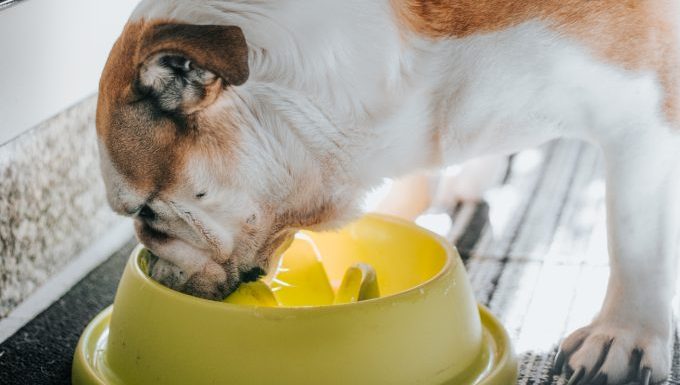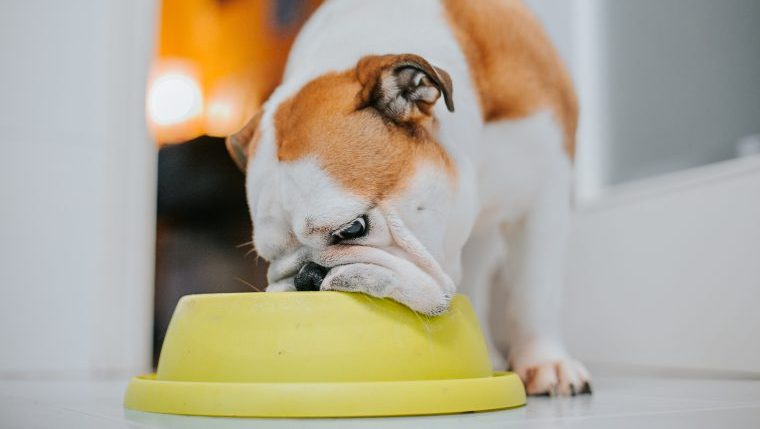
Slow-feeder bowls are the new “it” item with dog owners. Many varieties of these bowls are springing up on the pet market. Some are designed for functionality, others for aesthetics. So what’s all the fuss over a slightly different version of a pet bowl?
Slow-feeder bowls are designed to, as you might have guessed, slow down your dog’s eating. Some dogs gobble down their food so fast that they immediately get sick; this is both uncomfortable for them and an inconvenience for whoever has to clean it up.
However, using a slow feeder bowl also has more benefits that might not have occurred to most pet owners.
What are slow-feeder bowls?
Slow-feeder bowls differ from regular dog bowls in that the food is not designed to be easy to access. Slow-feeder bowls either allow dogs to access their food after completing basic “puzzles,” or there are built-in obstacles that force the dog to work around them to eat, slowing down the eating process. There’s a variety of slow feeder bowls on the market; some dogs like a challenge with their mealtime, while some will simply ignore their offered food if it’s too much of a hassle, so a simpler bowl works better.
Slow-feeder bowls can relieve many of the gastrointestinal issues that accompany eating too fast. For dog breeds who are prone to potentially life-threatening conditions such as bloat, this is an easy and inexpensive solution.
Common digestive issues in dogs
There are several common digestive issues in dogs that can be aided by the use of a slow-feeder bowl. Dogs who scarf down their food quickly may suffer from vomiting and diarrhea. On the milder side of things, they may just experience gas from air bubbles when consuming food too quickly; while this isn’t inherently harmful, it’s ideal to avoid it altogether.
But eating too quickly can also cause more concerning issues. Some dogs are already prone to a condition known as bloat. Bloat, a common name for gastric dilatation-volvulus (GDV) complex, is a medical condition where a stomach full of air twists, damaging the stomach and other internal organs. This condition is sadly often fatal, even with immediate veterinary care. This condition is common in large breeds that are highly food motivated, such as Labradors and Golden Retrievers.
Many of these conditions are easily preventable by simply changing your dog’s eating habits. Dogs who eat slowly are less likely to swallow down large mouthfuls of air, which can cause a range of gastrointestinal distresses.
How a slow-feeder bowl can help
While conditions such as bloat can seem scary, they’re often easily prevented. Slow-feeder bowls are intended to break up your dog’s meal into small mouthfuls. This keeps your dog from ingesting unwanted air. Additionally, it can allow your dog time to digest, keeping them from feeling hungry and begging for more food. With obesity a rising cause of health concerns in pets, keeping your dog’s mealtimes as standardized as possible can help keep their weight in check.
According to Veterinarians.org, slow feeder bowls can help reduce the risk of serious medical conditions by simply breaking up your dog’s mealtime. You may have additional success by feeding smaller meals within the slow feeder, as opposed to one large meal daily.
Choosing the right slow-feeder bowl
Not every slow-feeder bowl is meant for every dog. So, to increase your chances of success with a slow-feeder, find the right fit for your dog. If your dog is brachycephalic (short-snouted), like a Pug or Boxer, you may want to pick a wide bowl; a stout bowl may make accessing food too difficult. If your dog enjoys enrichment and games with food, consider making mealtime a challenging puzzle with food dispensers that require some work, such as a Nina Ottosson brand bowl.
Acclimating your dog to a slow feeder bowl doesn’t have to be a challenge. Consider using a slow feeder insert as opposed to a whole new bowl if your dog doesn’t like change. You can begin by offering meals in their regular bowl, and putting a few high-value treats in the slow feeder bowl, to drive home the point that the new bowl is fun and rewarding, not scary. Don’t fully remove the old bowl until you’re confident your pup is acclimated to the slow feeder.






